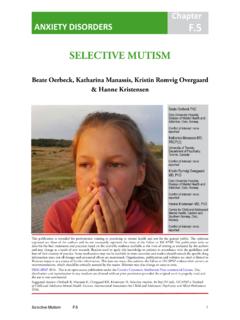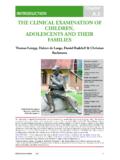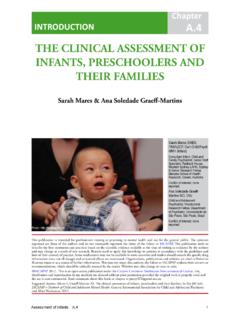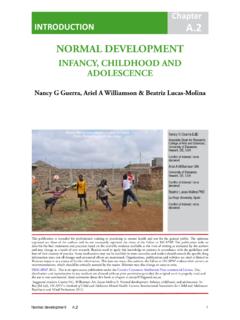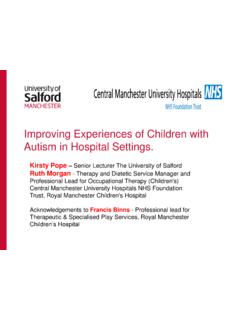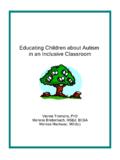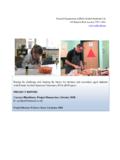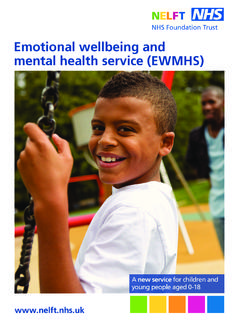Transcription of CONDUCT DISORDERS - iacapap.org
1 IACAPAP Textbook of Child and Adolescent Mental Health Chapter EXTERNALISING DISORDERS CONDUCT DISORDERS . Stephen Scott Stephen Scott BSc, FRCP, FRCP sych Professor of Child Health and Behaviour; Head, National Specialist CONDUCT Problems Clinic; Head, National Specialist Adoption and Fostering Clinic & Director of Research, National Academy for Parenting Practitioners, London, UK. Conflict of interest: none reported. This publication is intended for professionals training or practicing in mental health and not for the general public. The opinions expressed are those of the authors and do not necessarily represent the views of the Editor or IACAPAP.
2 This publication seeks to describe the best treatments and practices based on the scientific evidence available at the time of writing as evaluated by the authors and may change as a result of new research. Readers need to apply this knowledge to patients in accordance with the guidelines and laws of their country of practice. Some medications may not be available in some countries and readers should consult the specific drug information since not all dosages and unwanted effects are mentioned. Organizations, publications and websites are cited or linked to illustrate issues or as a source of further information.
3 This does not mean that authors, the Editor or IACAPAP endorse their content or recommendations, which should be critically assessed by the reader. Websites may also change or cease to exist. IACAPAP 2012. This is an open-access publication under the Creative Commons Attribution Non-commercial License. Use, distribution and reproduction in any medium are allowed without prior permission provided the original work is properly cited and the use is non-commercial. Send comments about this book or chapter to Suggested citation: Scott S. CONDUCT DISORDERS .
4 In Rey JM (ed), IACAPAP e-Textbook of Child and Adolescent Mental Health. Geneva: International Association for Child and Adolescent Psychiatry and Allied Professions 2012. CONDUCT DISORDERS 1. IACAPAP Textbook of Child and Adolescent Mental Health T. his section follows on from Chapter , oppositional defiant disorder, by focusing on CONDUCT disorder, which tends to occur in older children and teenagers. CLASSIFICATION. ICD-10. ICD-10 has a category for CONDUCT DISORDERS , F91. The clinical descriptions and diagnostic guidelines state: Examples of the behaviours on which the diagnosis is based include the following: excessive levels of fighting or bullying.
5 Cruelty to animals or other people; severe destructiveness to property; firesetting; stealing; repeated lying; truancy from school and running away from home; unusually frequent and severe temper tantrums; defiant provocative behaviour; and persistent severe disobedience. Any one of these categories, if marked, is sufficient for the diagnosis, but isolated dissocial acts are not.. (p267). An enduring pattern of behaviour should be present, but no time frame is given and there is no impairment or impact criterion stated. The ICD-10 diagnostic criteria for research differ, requiring symptoms to have been present for at least 6 months, and the introductory rubric indicates that impact upon others (in terms of violation of their basic rights), but not impairment of the child, can contribute to the diagnosis.
6 The research criteria take a menu-driven approach whereby a certain number of symptoms have to be present. 15 behaviours are listed to consider for the diagnosis of CONDUCT disorder, which usually but not exclusively apply to older children and teenagers. They can be grouped into four classes: Aggression to people and animals Often lies or breaks promises to obtain goods or favours or to avoid obligations Frequently initiates physical fights (this does not include fights with siblings). Has used a weapon that can cause serious physical harm to others ( , bat, brick, broken bottle, knife, gun).
7 Often stays out after dark despite parenting prohibition (beginning before 13 years of age). Exhibits physical cruelty to other people ( , ties up, cuts or burns a victim). Exhibits physical cruelty to animals. Destruction of property Deliberately destroys the property of others (other than by fire-setting). Deliberately sets fires with a risk or intention of causing serious damage). Deceitfulness or theft Steals objects of non-trivial value without confronting the victim, either within the home or outside ( shoplifting, burglary, forgery). CONDUCT DISORDERS 2.
8 IACAPAP Textbook of Child and Adolescent Mental Health Serious violations of rules Is frequently truant from school, beginning before 13 years of age Has run away from parental or parental surrogate home at least twice or has run away once for more than a single night (this does not include leaving to avoid physical or sexual abuse). Commits a crime involving confrontation with the victim (including purse-snatching, extortion, mugging). Forces another person into sexual activity Frequently bullies others ( , deliberate infliction of pain or hurt, including persistent Intimidation, tormenting, or molestation).
9 Breaks into someone else's house, building or car. To make a diagnosis, three symptoms from this list have to be present, one for at least six months. There is no impairment criterion. There are three subtypes: CONDUCT disorder confined to the family context ( ), unsocialised CONDUCT disorder ( , where the young person has no friends and is rejected by peers), and socialised CONDUCT disorder ( , where peer relationships are normal). It is recommended that age of onset be specified, with childhood onset type manifesting before age 10, and adolescent onset type after.
10 Severity should be categorised as mild, moderate, or severe according to number of symptoms or impact on others, , causing severe physical injury; vandalism; theft. Where there are sufficient symptoms of a comorbid disorder to meet diagnostic criteria, the ICD-10 system discourages the application of a second diagnosis, and instead offers single, combined categories. There are two major kinds: mixed DISORDERS of CONDUCT and emotions, of which depressive CONDUCT disorder ( ) is the best researched; and hyperkinetic CONDUCT disorder ( ). There is modest evidence to suggest these combined conditions may differ somewhat from their constituent elements.
